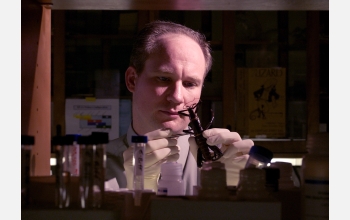Multimedia Gallery
Professor Michael Whiting in his lab at BYU
Michael Whiting, a professor of integrative biology at Brigham Young University, examines a walking stick in his lab.
More about this Image
In January 2003, Michael Whiting, a Brigham Young University integrative biology professor, announced that he and colleague Taylor Maxwell had discovered genetic evidence that indicates many species of walking sticks -- a group of insects that mimic twigs to stay hidden from predators -- lost their ability to fly, but then re-evolved the capacity 50 million years later. The findings were reported in the Jan. 16, 2003, cover article of the scientific journal Nature.
Whiting and Maxwell first began working together when Whiting received a National Science Foundation grant (DEB 0120718) to construct the family tree of the insect class. He asked Maxwell to sequence and analyze the DNA of 35 species of walking sticks as part of the broader study to determine which evolved first. Maxwell, supported in part by an NSF grant designed to facilitate undergraduates' participation in research, put together preliminary results. They found that some species of walking sticks without wings existed before their winged descendants.
These findings were the first time any organism had been shown to have re-evolved a complex trait, something scientists previously thought impossible. In the evolutionary process, it is believed that complex functions such as flight or sight, if not used, will evolve out of a species. The "Encyclopedia of Evolution" cites Dollo's law, the principle that organs or complex structures cannot return to a condition seen in an ancestor.
Entomologists have documented many cases where insect species lost their ability to fly. For example, an insect whose habitat may change over time would evolve to survive more easily in the habitat. Whiting suggests that walking sticks may have lost wings to help them blend in with their surroundings. He also noted that wingless insects have been found to lay more eggs than winged relatives. This could have been important for walking sticks because instead of burying their eggs in the ground as similar species do, they drop them to the earth from their homes in treetops. The more eggs the wingless walking stick produces, the more chances it has to pass along genes to the next generation.
For whatever reason, some 50 million years ago, it was advantageous to have some of the species become winged again. Now there are both winged and wingless species of walking sticks. What's remarkable is that they had the ability to generate wings when they needed them. (Year of image: 2003)
Credit: Insect Molecular Genomics Lab, Brigham Young University; photo by Mark A. Philbrick/BYU
Images and other media in the National Science Foundation Multimedia Gallery are available for use in print and electronic material by NSF employees, members of the media, university staff, teachers and the general public. All media in the gallery are intended for personal, educational and nonprofit/non-commercial use only.
Images credited to the National Science Foundation, a federal agency, are in the public domain. The images were created by employees of the United States Government as part of their official duties or prepared by contractors as "works for hire" for NSF. You may freely use NSF-credited images and, at your discretion, credit NSF with a "Courtesy: National Science Foundation" notation.
Additional information about general usage can be found in Conditions.
Also Available:
Download the high-resolution JPG version of the image. (1.3 MB)
Use your mouse to right-click (Mac users may need to Ctrl-click) the link above and choose the option that will save the file or target to your computer.



 All images in this series
All images in this series